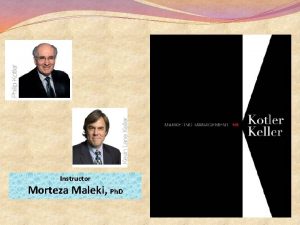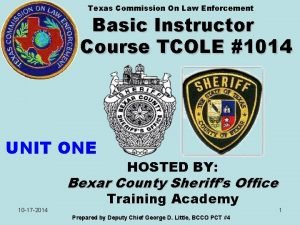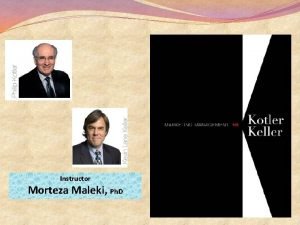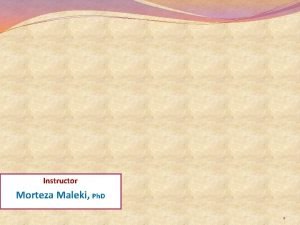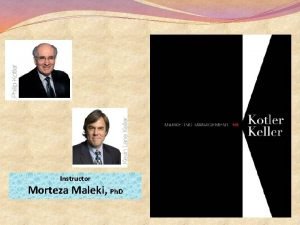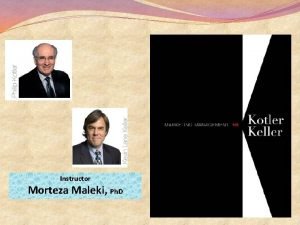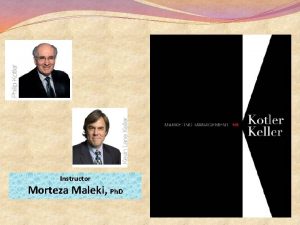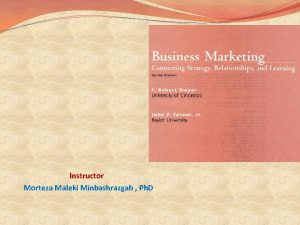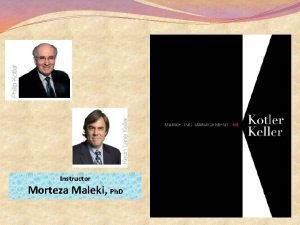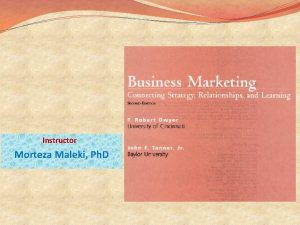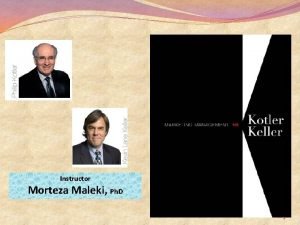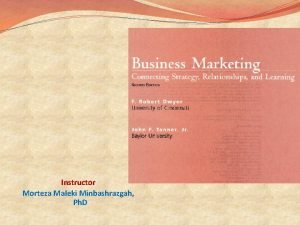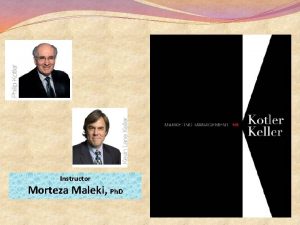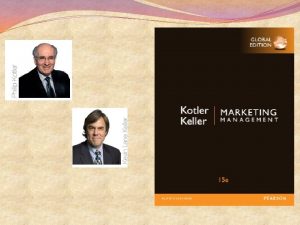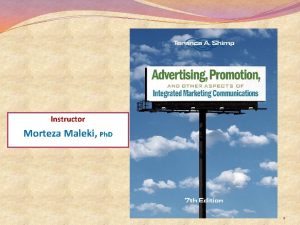Instructor Morteza Maleki Ph D At the Heart




















































- Slides: 52

Instructor Morteza Maleki, Ph. D

At the Heart of a Great Brand is a Great Product.

Introduction ü The customers judge the companies’ offering by three basic elements: 1. 2. 3. Product features and quality Services mixes and quality Price 3

Product Features & Characteristics ü A product is anything that can be offered to a market to satisfy a want or need. ü It includes physical goods, services, experiences, events, persons, places, properties, organizations, information, & ideas. Product Levels: The Customer-Value Hierarchy ü In planning its market offering, the marketer needs to address five product levels; ü Each level adds more customer value, & the five constitute a customer value hierarchy. 4

Product Features & Characteristics Five Product Levels 5

Product Features & Characteristics Five Product Levels The fundamental level is the customer is really buying. 1. ü core benefit: the service or benefit the The hotel guest buy “rest & sleep”. At the second level, the marketer must turn the core benefit into a basic product. 2. ü A hotel room includes a bed, bathrooms, towels, desk, dresser, & closet. At the third level, the marketer prepares an expected product, a set of attributes and conditions buyers normally expect when they purchase this product. 3. ü ü Hotel guest expect a clean bed, fresh towels, working lamps, & a relative degree of quiet. In developing and emerging markets, competition takes place mostly at this level. 6

Product Features & Characteristics At the fourth level, the marketer prepares an exceeds customer expectations. 4. ü augmented product that In developed countries, brand positioning and competition takes place at this level; The fifth level is potential product, encompassing all the possible augmentations & transformations the product or offering might undergo in the future. 5. ü Here is where companies search for new ways to satisfy customers and distinguish their offering. 7

Product Features & Characteristics ü Differentiation arises & competition increasingly occurs on the basis of product augmentation. ü This leads the marketer to look at the users’ total consumption system. ü Total Consumption System is the way the user performs the task of getting and using the products & related services. Note ü Each augmentation adds costs, however, and augmented benefits soon become expected benefits and necessary point of parity. 8

Product Features & Characteristics Metamarkets & Metamediaries ü There are some products whose purchase necessitates other purchases; ü The new automobile market is a good example of metamarket. ü The consumer chooses an automobile but also must buy insurance from an insurance company often must get a loan from a bank. ü A smart auto company or auto dealer would make all three purchases easy for the buy by partnering with an insurance company and a bank. ü Such an auto dealer is performing as Metamediaries. ü Metamarkets are the result of marketers observing the total consumption system and “packaging” a system that simplifies carrying out these related product/service activity. 9

Product Classifications 1. Durability & Tangibility ü Nondurable goods are tangible goods normally consumed in one or a few uses, such as soft drink or soap. ü ü Durable goods are tangible goods that normally survive many uses: refrigerators, machine tools, and clothing. ü ü Because these goods are purchased frequently, the appropriate strategy is to make them available in many locations, charge only a small markup, and advertise heavily to induce trial and build preference. They normally require personal selling and service, command a higher margin, and require more seller guarantees. Services are intangible, inseparable, variable, & perishable product. ü ü They normally require more quality control, supplier credibility, and adaptability. Example includes haircut, legal advice, & appliance repairs. 10

Product Classifications 2. Consumer-Goods Classifications ü Consumer goods are classified based on the basis of shopping habits. ü The consumers usually purchases Convenience Goods frequently, immediately, and with a minimum of effort. ü ü Examples include soft drinks, soaps, newspapers. They are further classified as: 1. Staples Goods 2. Impulse Goods 3. Emergency Goods ü Unsought goods are those the consumers does not know about or does not normally think of buying. ü ü Examples include life insurance, encyclopedias, and reference books. It requires advertising and personal selling efforts. 11

Product Classifications ü Shopping goods are goods that the consumer characteristically compares on such basis as suitability, quality, price and style. ü ü Examples include furniture, clothing, used cars, and major appliance. They are further classified as: 1. Homogeneous Shopping Goods 2. Heterogeneous Shopping Goods ü Specialty goods have unique characteristics or brand identification for which a sufficient number of buyers are willing to make a special purchasing effort. ü ü Examples include cars, stereo components, photographic equipment, & men’s suit. They don’t require comparisons; buyers invest time only to search dealers carrying the wanted products. 12

Product Classifications 3. Industrial-Goods Classifications ü Industrial goods can be classified in terms of their relative costs & how they enter into the production process. ü Materials & Parts are goods that enter the manufacturer’s product completely. ü They fall into two classes; 1. Raw materials Farm products, like wheat, cotton, livestock, fruits, & vegetables. 2. Natural products, like fish, lumber, crude petroleum, iron ore. 1. Manufactured materials and parts 2. 1. 2. Component materials, like iron, yarn, cement, wires. Component parts, like small motors, tires, castings. 13

Product Classifications ü Capital items are long-lasting goods that facilitate developing or managing the finished product. ü They include two groups; ü ü Installations, including buildings (factories, offices), heavy equipment (generators, drill presses, mainframe computers, elevators) Equipment, including portable factory equipment and tools (hand tools, lift trucks), and office equipment (personal computers, desks). 14

Product Classifications ü Supplies & business services are short-term goods and services that facilitate developing or managing the finished products. ü Supplies are of two kinds; Maintenance & repair items, like paint, nails, brooms. ü Operating supplies, like lubricants, coal, writing paper, pencils. ü ü ü Together, they go under the name on MRO goods. Business services include Maintenance and repair services (maintenance of air conditioning, repair of photocopying machines) ü Business advisory services (legal, management consulting, advertising) ü 15

Differentiation ü To be branded, products must be differentiated. ü ü At one extreme, we find products that allow little variation; chicken, aspirin, and steel. At the other extreme are products capable of high differentiation, such as automobiles, commercial buildings, and furniture. ü In services, differentiation is often achieved through the use of technology and by offering value-added services. 16

Differentiation Product Differentiation 1. Form ü 1. ü ü The size, shape, or physical structure of a product. Features The company can identify and select appropriate new features by surveying recent buyers & then calculating customer value versus company cost for each potential features. The company should also consider ü ü How many people want each feature, How long it would take to introduce it, Whether competitors could easily copy it. Companies must also think in terms of feature bundles or packages. 17

Differentiation Customization ü As companies has grown proficient at gathering info about individual customers and business partners, and as their factories are being designed more flexibly, they have increased their ability to individualize market offerings, messages and media. 3. � Mass customization the ability of a company to meet each customer’s requirements—to prepare on a mass basis individually designed products, services, programs, and communications. 18

Differentiation Performance Quality ü It is the level at which the product’s primary characteristics operate. 4. Most products are established at one of four performance levels; 1. Low performance 2. Average performance 3. High performance 4. Superior performance ü The manufacturer must design a performance level appropriate to the target market and competitor’s performance levels. ü Manage performance quality through time ü Continuous improving ü 19

Differentiation Conformance Quality 5. ü It is the degree to which all the produced units are identical and meets the promised specifications. ü Durability 6. ü The problem with low conformance quality is that the product will disappoint some buyers. It is a measure of the product’s expected operating life under natural or stressful conditions. ü Yet, this rule is subject to some qualifications; 1. The extra price must not be excessive. 2. The product must not be subject to rapid technological obsolescence. 20

Differentiation Reliability 7. ü It is a measure of the probability that a product will not malfunction or fail within a specified time period. Repairability 8. ü It is a measure of the ease of fixing a product when it malfunctions or fails. ü Style 9. ü Ideal repairability would exist if users could fix the product themselves with little cost in money or time. It describes the product’s look and feel to the buyers. ü ü It has the advantage of creating distinctiveness that is difficult to copy. Yet, strong style does not always mean high performance. 21

Service Differentiation ü When a physical product can not easily be differentiated, the key to the competitive success may lie in adding valued services and improving their quality. ü The main service differentiators are 1. 2. 3. 4. 5. 6. 7. Ordering Ease Delivery Installation Customer Training Customer Consulting Maintenance & Repair Returns 22

Service Differentiation Ordering Ease 1. ü It refers to how easy it is for the customer to place an order with the company. Delivery 2. ü It refers to how well the product or service is brought to the customer. ü It includes speed, accuracy, & care throughout the process. 23

Service Differentiation Installation 3. ü It refers to the work done to make a product operational in its planned location. ü It is important for companies with complex products. Customer Training 4. ü It refers to training the customer’s employees to use the vendor’s equipment properly & efficiently. 24

Service Differentiation Customer Consulting 5. ü It refers to data, info systems, and advice services that the sellers offer to buyers. Maintenance & Repair 6. ü It describes the service program for helping customers keep purchased products in good working order. 25

Service Differentiation Returns 7. ü Although product returns are undoubtedly a nuisance to customers, manufacturers, retailers, and distributors alike, they are also unavoidable reality of doing business, especially with online purchases. ü We can think of product returns in two ways; Controllable returns 2. Uncontrollable returns 1. 26

Design ü Design is the totality of features that affect how a product looks, feels, and functions in terms of customer requirements. ü The designer must figure out how much to invest in form, feature development, performance, conformance, durability, reliability, repairability, & style. ü To the company ü A well-designed product is the one that is easy to manufacture and distribute. ü To the customer, ü A well-designed product is the one that is pleasant to look at and easy to open, install, use, repair, and dispose of. 27

Design The Importance of Design ü The emotional power of design and the importance to consumers of how things look and feel as well as work ü In an increasingly visually oriented culture, transmitting brand meaning and positioning through design is critical. ü Design can shift consumer perceptions to make brand experiences more rewarding. ü Design should penetrate all aspects of the marketing program so that all design aspects work together. ü Universal identity scheme for Coca-Cola: 1. 2. 3. 4. Bold simplicity, Real authenticity The power of red, and A “familiar yet surprising” nature 28

Design Thinking ü Design thinking is a very data-driven approach with three phases: 1. Observation, 2. Ideation, and 3. Implementation ü Design thinking requires intensive ethnographic studies of consumers, creative brainstorming sessions, and collaborative teamwork to decide how to bring the design idea to reality. 29

Product & Brand Relationships ü Each product can be related to other products to ensure that a firm is offering and marketing the optimal set of products. The Product Hierarchy ü Need Family—the core need that underlies the existence of a product family. ü Example; security ü Product family—all the product classes that can satisfy a core need with reasonable effectiveness. ü Example: savings & income ü Product Classes (Product category)—a group of products within the product family recognized as having a certain functional coherence. ü Example: financial instruments 30

Product & Brand Relationships ü Product line—a group of products within a product class that are closely related because they perform a similar function, are sold to the same customer groups, are marketed through the same outlets or channels, or fall within a given price ranges. ü Example: life insurance ü Product Type—a group of items within a product line that share one of several possible forms of product. ü Example: term life insurance ü Item (Stock Keeping Unit or Product Variant)—a distinct unit within a brand or product line distinguishable by size, price, appearance, or some other attributes. ü Example: ICICI Prudential renewable term life insurance 31

Product & Brand Relationships Product Systems & Mixes ü Product system is a group of diverse but related items that function in a compatible manner. ü A product mix (product assortment) is the set of all products & items a particular sellers offer for sale. ü A product mix consists of various product lines ü The company’s product mix has a certain width, length, depth, & consistency. 1. 2. 3. 4. Width: refers to how many product lines the company carry (5 Product Lines). Length: refers to the total number of items in the mix (20). Depth: refers to how many variants are offered of each product in the line Consistency: refers to how closely related the various product lines are in end use, production requirements, distribution channels, etc. 32

Product & Brand Relationships 33

Product & Brand Relationships Product Line Analysis ü In offering a product line, companies normally develop a basic platform and modules that can be added to meet different customer requirements. ü For instance, car manufacturers build their cars around a basic platform. ü Sales & Profits ü Every company’s product portfolio contains products with different margins. ü A company can classify its products into four types that yield different gross margins: 1. Core products 2. Staples 3. Specialties 4. Convenience items 34

Product & Brand Relationships Market Profile ü A product line manager must review how the line is positioned against competitors’ lines. ü A product map shows which competitors’ items are competing against the company items. ü ü The map can also reveal the possible locations of new product offerings. It also can identify the market segments. ü Product line analysis provides info for two key decision areas: ü Product-line length ü Product-mix pricing 35

Product & Brand Relationships 36

Product & Brand Relationships Product-Line Length �Company objective influence product-line length: 1. 2. 3. One objective is to create a product line to induce upselling. A different objective is to create a product line that facilitates cross-selling. Another objective is to create product that protects against economics ups and downs. �Companies seeking high market share & market growth will generally carry longer product lines. �Companies that emphasize high profitability will carry shorter lines consisting of carefully chosen items. 37

Product & Brand Relationships ü Product lines tend to lengthen over time: ü Excess manufacturing capacity puts pressures on the product-line manager to develop new items. ü The salesforce and distributors pressure the company for a more complete product line to satisfy customers. ü A company lengthens its product line in two ways: 1. Line Stretching ü It occurs when a company lengthens its product lines beyond its current range. It is of three types: 1. 2. 3. Down-market Stretch Up-market Stretch Two-way Stretch 38

Product & Brand Relationships Line Filling 2. ü A firm can also lengthen its product line by adding more items within the present range. ü There are several motives for such action; 1. 2. 3. 4. 5. Reaching for incremental profits, Trying to satisfy dealers who complain about lost sales because of missing items in the line Trying to utilize the excess capacity Trying to be leading full-time company, & Trying to plug holes to keep out competitors ü Line-filling is overdone if it results in self-cannibalization and customer confusion. ü The company needs to differentiate each item in the consumers’ minds with a just noticeable difference. 39

Product & Brand Relationships 4. Line Modernization, Featuring, & Pruning ü Product lines need to be modernized; two approaches in modernization are: ü ü Piecemeal approach All at once ü Companies plan improvements to encourage customer migration to higher-valued, higher-priced items. ü The major issue: timing of improvements: ü Too early; damaging the sales of the current line ü Too late; after the competition has established a strong reputation for more- advanced equipment. 40

Product & Brand Relationships Product-Mix Pricing ü In product-mix pricing, the firm searches for a set of prices that maximizes profits on the total mix. ü Six situations calling for product-mix pricing: 1. 2. 3. 4. 5. 6. Product-Line Pricing Optional-Feature Pricing Captive-Product Pricing Two-Part Pricing By-Product Pricing Product-Bundling Pricing 41

Product & Brand Relationships Co-Branding & Ingredient Branding ü Also called dual branding or Brand Bundling, in co-branding, two or more well-known brands are combined into a joint product or marketed together in some fashion. 1. Same-company branding ü 2. Joint-venture co-branding ü 3. General Electric and Hitachi lightbulbs in Japan Multiple-sponsored co-branding ü 4. General Mills advertises Trix cereal and Yoplait yogurt Taligent, a one-time technological alliance of Apple, IBM, and Motorola Retail co-branding ü Jointly owned Pizza Hut, KFC, and Taco Bell restaurants 42

Product & Brand Relationships Advantages 1. 2. 3. 4. Product may be convincingly positioned by virtue of the multiple brands. It can generate greater sales from the existing target market as well as opening additional opportunities for new consumers & channels. It can reduce the cost of introducing new products. It is a valuable means to learn about consumers and how other companies approach them. 43

Product & Brand Relationships Disadvantages 1. 2. 3. 4. The risks and lack of control in becoming aligned with other brand in the minds of consumers. Consumer expectations about the level of involvement and commitment with co-brands are likely to be high, so unsatisfactory performance could have negative repercussions for both brands. If the other brands has entered into a number of co-branding arrangements, overexposure may dilute the transfer of any association. It may result in a lack of focus on existing brands. 44

Product & Brand Relationships For co-branding to succeed: ü The two brands must separately have brand equity Adequate brand awareness ü Sufficiently positive brand image ü ü A logical fit between two brands should exist 45

Product & Brand Relationships ü Ingredient Branding is a special case of co-branding. ü ü It creates brand equity for materials, components, or parts that are necessarily contained within other branded products. In “self-branding”, companies advertise and even trademark their own branded ingredients. ü Ingredient brands try to create enough awareness & preference for their products so consumers will not buy a “host” product that does not contain the ingredients. 46

Packaging, Labeling, Warranties, & Guarantees Packaging ü Packaging is all the activities of designing & producing the container for a product. ü Packages might include up to three levels of materials: 1. Primacy package 2. Secondary package 3. Shipping package ü Factors contributing to the growing use of packaging: 1. Self-service 2. Consumer affluent 3. Company & brand image 4. Innovation opportunity 47

Packaging, Labeling, Warranties, & Guarantees ü From the perspective of both the firm and consumers, packaging must achieve a number of objectives: 1. 2. 3. 4. 5. Identify the brand Convey descriptive & persuasive information Facilitate product transportation Assist at-home storage Aid product consumption ü After a company designs its packaging, it must test it: 1. 2. 3. 4. Engineering tests Visual tests Dealer tests Consumer tests 48

Packaging, Labeling, Warranties, & Guarantees Labeling ü The label may be a simple tag attached to a product or an elaborately designed graphic that is part of the package. ü It might carry only the brand name, or a great deal of information. ü Labels perform several functions: 1. It identifies the product and the brand. 2. It might grade the product. 3. It might describe the product. 4. It might promote the product through attractive graphics. 49

Packaging, Labeling, Warranties, & Guarantees Warranties & Guarantees ü Warranties are formal statements of expected product performance by the manufacturer. ü ü ü Products under warranty can be returned to the manufacturer, or designated repair center for repair, replacement, or refund. Whether expressed or implied, warranties are legally enforceable. It require payment on the part of the customer to make it legally viable (differencebetween. net). ü The necessity of guarantee also emerged as a means of protection to safeguard the right of the consumer. ü Unlike warranty which is given by most of the retail sellers or distributors, it is generally given by manufacturers. 50

Packaging, Labeling, Warranties, & Guarantees The difference between guarantee & warranty ü Generally, one can get his money back with the strength of guarantee, if the product is defective or does not provide the assured standard. ü Warranty, on the other hand, implies the provision of getting the article repaired if the product is defective. 51

The End 52
 Morteza maleki
Morteza maleki Morteza maleki
Morteza maleki Insertion sort pseudocode
Insertion sort pseudocode Morteza anvari
Morteza anvari Morteza farajian
Morteza farajian Morteza
Morteza Isaep model
Isaep model Cost analyst
Cost analyst Morteza farajian
Morteza farajian Morteza rahmatian
Morteza rahmatian Morteza farajian
Morteza farajian Third heart sound
Third heart sound Left atrium sheep heart
Left atrium sheep heart Heart 2 heart
Heart 2 heart Tcole advanced instructor course
Tcole advanced instructor course Marksmanship instructor
Marksmanship instructor Basic instructor course texas
Basic instructor course texas Basic instructor course texas
Basic instructor course texas Acr medical term
Acr medical term Delmar cengage learning instructor resources
Delmar cengage learning instructor resources Nra certified instructor logo
Nra certified instructor logo Tp 12863
Tp 12863 Instructor
Instructor Instructor vs teacher
Instructor vs teacher Tcole advanced instructor course
Tcole advanced instructor course Nrp instructor toolkit
Nrp instructor toolkit Basic instructor course #1014
Basic instructor course #1014 Basic instructor course tcole
Basic instructor course tcole Instructor office hours
Instructor office hours Naismith was an instructor of
Naismith was an instructor of Instructor operating station
Instructor operating station Ac61-98 plan of action
Ac61-98 plan of action Cisco certified instructor
Cisco certified instructor Jrotc marksmanship instructor course online
Jrotc marksmanship instructor course online Basic instructor course #1014
Basic instructor course #1014 Utp cable
Utp cable Virtual instructor art
Virtual instructor art Pepperball hotshot
Pepperball hotshot Please clean your own room
Please clean your own room Catia instructor
Catia instructor Tcole 1014 basic instructor course
Tcole 1014 basic instructor course Mptc firearms instructor
Mptc firearms instructor Basic instructor course texas
Basic instructor course texas Which line is longer illusion
Which line is longer illusion Tcole basic instructor course
Tcole basic instructor course Tipología de los participantes y como tratarlos
Tipología de los participantes y como tratarlos Cbrf registry wisconsin
Cbrf registry wisconsin Nfpa 1403 instructor to student ratio
Nfpa 1403 instructor to student ratio Not only the students but also the instructor
Not only the students but also the instructor Bảng số nguyên tố lớn hơn 1000
Bảng số nguyên tố lớn hơn 1000 đặc điểm cơ thể của người tối cổ
đặc điểm cơ thể của người tối cổ Các châu lục và đại dương trên thế giới
Các châu lục và đại dương trên thế giới Chụp tư thế worms-breton
Chụp tư thế worms-breton








